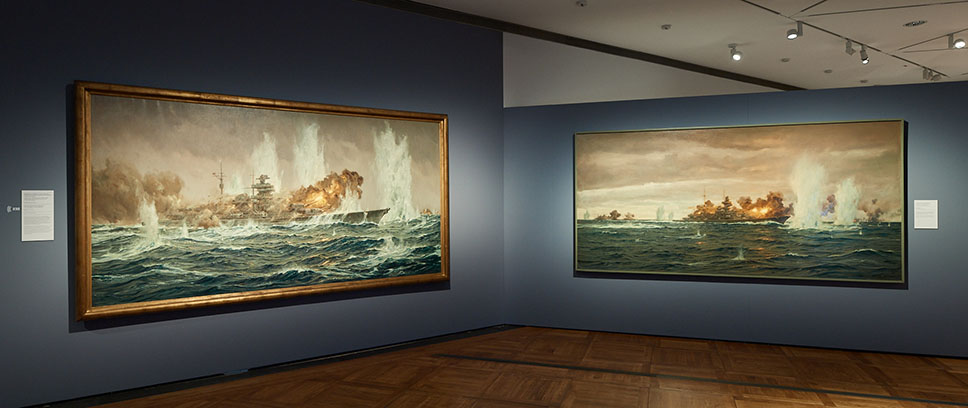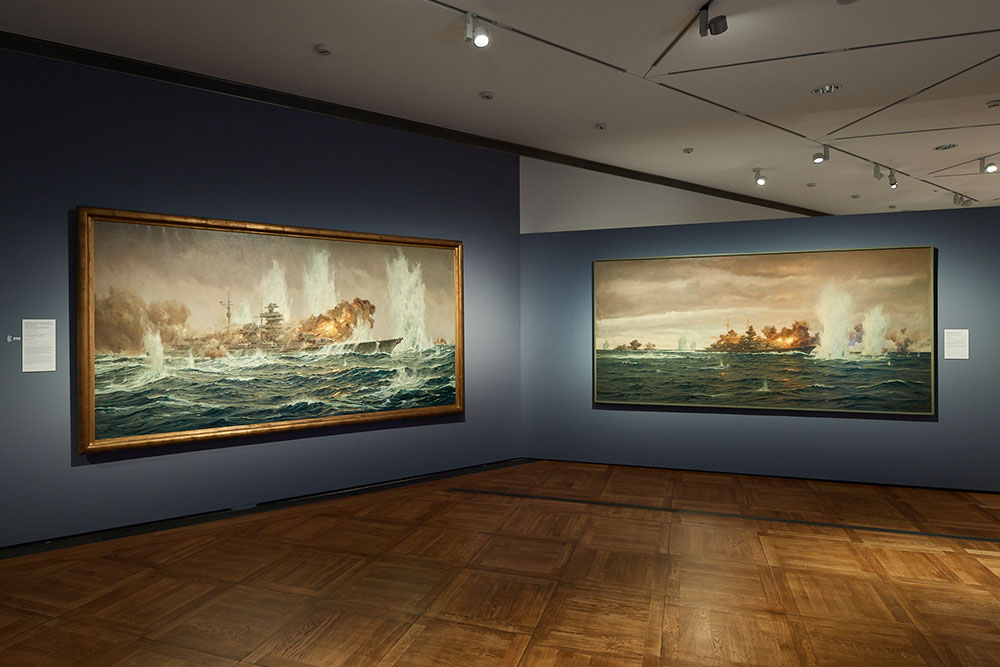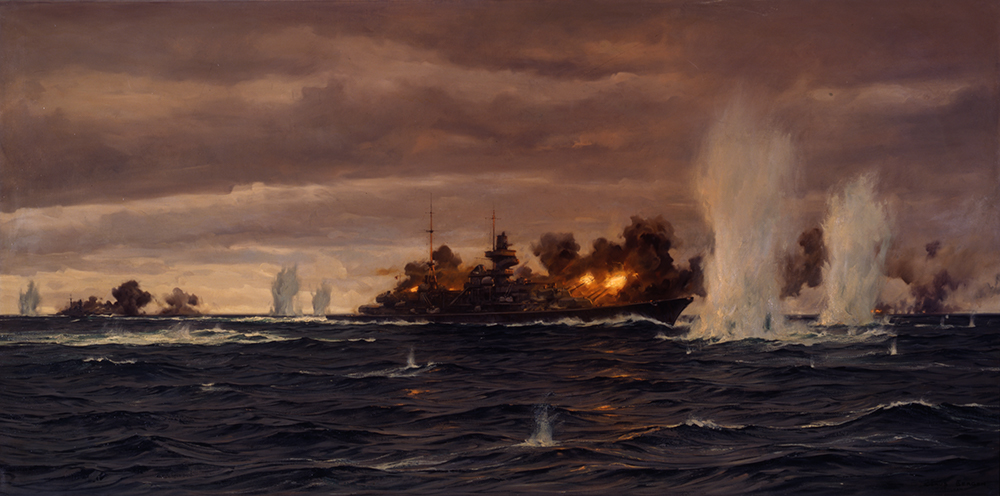
What’s that for? The painting “Heavy Cruiser ‘Prinz Eugen’ in the Battle of the Denmark Strait”
Ambra Frank | 2. Dezember 2021
The large-format oil painting “Heavy Cruiser ‘Prinz Eugen’ in the Battle of the Denmark Strait” from 1944 was painted by Claus Bergen (1885–1964). In the DHM exhibition “‘Divinely Gifted’. National Socialism’s Favoured Artists in the Federal Republic” the picture raised questions about the continuity of the subject of political marine painting and how to deal with Nazi cultural goods. Ambra Frank, research associate in the exhibition, tells us more about it.
The artist Claus Bergen, born in Stuttgart in 1885, was successful not only during the Nazi period and was known beyond the German-speaking regions. In the 1964 April edition of Life magazine, the editors published the laudatory article “Most Adventurous Sea Painter of His Day” and used some of his works to illustrate an article about naval battles in the First World War. Bergen’s career had begun in Wilhelminian Germany, and with the display of his paintings of the Battle of Skagerrak in the Munich Glass Palace exhibition in 1918, he established himself as a marine artist and received numerous orders for such paintings from that time on. In the mid-1920s, he completed several large-scale paintings on behalf of Oskar von Miller (1885–1934), which were used to decorate the naval hall of the German Museum in Munich, at the time the largest natural science museum in the world.[1]

In May 1941, the battleship “Bismarck”, a propaganda object built to demonstrate the technical superiority of the German military navy, and the heavy cruiser “Prinz Eugen” put to sea for “Operation Rheinübung”. They were to engage in the trade war in the North Atlantic and attack the convoys bringing supplies to Great Britain. On 23 May, the two German ships were sighted by the British Royal Navy. Shortly thereafter, on 24 May, a historic naval battle took place in the Denmark Strait between Greenland and Iceland. Together, the “Bismarck” and the “Prinz Eugen” sank the British battle cruiser “Hood”, then the most formidable ship and the pride of the Royal Navy. The Royal Navy thereupon set all available warships against the “Bismarck”. The pursuit ended with the sinking of the “Bismarck” in the North Atlantic on 27 May 1941. The Nazi leadership instrumentalised the death of the German sailors and glorified the fall of the “Bismarck” with heroizing rhetoric as a sacrifice for “Folk and Fatherland”. Claus Bergen – who had been a member of the NSDAP since 1932 and had been awarded the War Merit Cross 2nd Class in 1944[2] – depicted the Battle of the Denmark Strait and the sinking of the “Bismarck” in large-scale paintings. They were finished in 1944 and 1949 – the last months of the Nazi dictatorship and the year of the founding of the Federal Republic.

The nearly three-metre wide oil painting “Heavy Cruiser ‘Prinz Eugen’ in the Battle of the Denmark Strait” was presented in 1944 at the “Great German Art Exhibition” (1937–1944) in the House of German Art in Munich and purchased there for 25,000 Reichsmarks by Adolf Hitler. The Nazi propagandists interpreted the event it portrays as a victorious battle in which the German Kriegsmarine demonstrated the superiority of Nazi Germany over Great Britain’s naval power. Each year Bergen presented works at the “Great German Art Exhibition” (GDK), often with programmatic content. These included “Ran an den Feind” (GDK 1941, Attack the Enemy) and “Gegen England” (GDK 1940, Against England). In 1939 he showed the painting “Wikinger” (Vikings), which can be understood[3] as a reference to the racial-ideological legend of the “bloodline of the German Vikings”.[4] After the war “Heavy Cruiser ‘Prinz Eugen’ in the Battle of the Denmark Strait” and other paintings by Bergen were confiscated by the American military government and brought to the USA as part of the “German War Art Collection” (GWAC).
Claus Bergen was represented with several paintings in this collection of around 9,000 works. Accordingly, the American military government must have seen his paintings as putatively Nazi art and/or as glorifying the war. That meant that they had to be inaccessible to the German population. Nowadays, this policy of the “poison cabinet”[5] is no longer acceptable. But in the context of the Potsdam Agreement and the knowledge of the Allies about the intensive dissemination and propagandistic contextualization of art under the Nazis, it was entirely understandable. The restitution of ten of Bergen’s paintings, including “Heavy Cruiser ‘Prinz Eugen’ in the Battle of the Denmark Strait”, took place in 1979 upon the initiative of the German lawyer and Claus Bergen collector Hanswilly Bernartz from Cologne. He achieved the return of the works through a lawsuit. He expressed his opinion in an interview that was broadcast in 1979:
“I have always held these expropriations of the Americans to be unlawful and denoted them as such. I see no legal basis for it at all, for if you look here, for example, (…) these are all historical motifs and they do not consist of military works that could somehow justify [the Americans] taking them away, practically plundering them, stealing them.”[6]
The assertion that the GWAC consisted of cultural goods stolen by the victorious power is just as untenable as the attempt to deny that Bergen’s works contain military content, and it negates the real aim of denazification. The return of the artworks was important for Hanswilly Bernartz and could possibly be seen as a revisionist act.
In 1986, 7,000 additional works from the GWAC were turned over to the Federal Republic and have been reposited in the DHM since the end of the 1990s. There they are available for scholarly research.[7]
“Heavy Cruiser ‘Prinz Eugen’ in the Battle of the Denmark Strait” as well as the painting “The Last Battle of the ‘Bismarck’”, completed in 1949, are on display In the DHM exhibition. The latter picture shows the battleship “Bismarck” a few hours before it was sunk in the North Atlantic on 27 May 1941. In 1963, the industrialist Hermann Reusch donated it to the naval school in Flensburg-Mürwik. The ceremonial handover took place exactly 22 years after the event it depicts, on 27 May 1963. Claus Bergen took part in the festivities, and in his speech naval captain Gerhard Bidlingmaier commemorated “(…) the battle and the sinking of the ‘Bismarck’”.[8] This was entirely in line with Hermann Reusch, who donated the painting with the aim of “filling a gap at the naval school in the depiction of the Second World War that existed until now”.[9] At the ceremony, the approval of Bergen’s political naval painting was unbroken, once more evoking the rhetoric of the dubious sacrificial death of the sailors.[10]
When we were developing the concept for the exhibition on the “Divinely Gifted” artists, we were very aware of the potential misinterpretation of the works we were showing and asked ourselves why, for example, was it important to present the paintings of the “Prinz Eugen” and the “Bismarck”. They are, in fact, prime examples of the core subject of the exhibition: the continuities of art and artists of National Socialism before and after the war. The two paintings by Claus Bergen clearly form a narrative coherence and exemplify the problematic culture of remembrance of the victims of the Second World War in the early Federal Republic as well as the way the (cultural) legacy of the Nazi period was dealt with.
[1] Cf. Hormann, Jörg-Michael: Claus Bergen. Marinemaler über vier Epochen, Koehler Verlag, Hamburg, 2002, pp. 75–78.
[2] Cf. Spruchkammerakte Claus Bergen, Staatsarchiv München, SpKA_K_119_Bergen, Claus sowie Schreiben Ministerialdirektor Hinkel an Claus Bergen, Benachrichtigungsschreiben über die Verleihung des Kriegsverdienstkreuzes II. Klasse ohne Schwerter, 30. März 1944, BArch, R 9361/V98477.
[3] Cf. Herzog, Bodo: Die Berliner Kunstausstellung im Jahre 1940 – „Helden des U-Boot-Krieges… Rassisch hochwertiges Menschenmaterial“, in: Kritische Berichte, Heft 1, Jg. 12, 1984, pp. 62/71–72.
[4] Cf. Claus Bergen at www.gdk-research.de
[5] Cf. Voss, Julia: Ein Tabu wird gebrochen, in: FAZ, 17.10.2011
[6] Feuer und Farbe. Das Dritte Reich und seine Maler zwischen Heros und Horror, Itzchak Pruschnowski, SFB, 1979.
[7] In the course of the dissertation project “‘A Potential Threat to the World?’ Zur Genese, Funktion und Rezeption der German War Art Collection” (WT), Darja Jesse is doing research on the GWAC at the DFG graduate school “Identity and Heritage”.
[8] Schreiben Kapitän z. S. Dr. Schneider-Pungs an Hermann Reusch, Flensburg-Mürwik, 6. Juni 1963, Archiv Marineschule Mürwik, CAEC9185 Bergen – Bismarck 1963-06-06 MSM
[9] Schreiben Hermann Reusch an Kapitän z. S. Dr. Schneider-Pungs, Oberhausen, 20. Mai 1963, Archiv der Marineschule Mürwik, CAEC9815 Bergen – Bismarck 1963-05-20 Reusch
[10] “The Last Battle of the ‚Bismarck’” is still in possession of the naval school, where it is displayed in the antechamber of the assembly hall with a critical historical commentary. In the course of the doctoral project “Maritime Art from the time of National Socialism in Lübeck and Schleswig-Holstein” (WT), Greta Paulsen is researching the topic, including Claus Bergen, at the Zentrum für Kunstwissenschaftliche Forschung Lübeck.